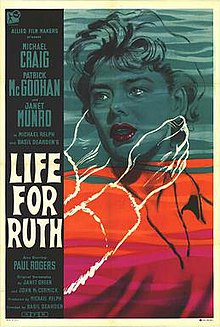|
Life for Ruth
Life for Ruth (U.S. title: Walk in the Shadow) is a 1962 British drama film produced by Michael Relph directed by Basil Dearden and starring Michael Craig, Patrick McGoohan and Janet Munro.[2] PlotJohn Harris finds himself ostracized and placed on trial for allowing his daughter Ruth to die. His religious beliefs forbade him to give consent for a blood transfusion that would have saved her life. Doctor Brown is determined to seek justice for what he sees as the needless death of a young girl. Cast
ProductionThe film was based on an original script by the husband and wife team of Janet Green and John McCormick, who had written Sapphire and Victim for Dearden and Relph. They wrote it in 1961 under the title God the Father then A Matter of Conscience.[3] Michael Craig had worked with Dearden and Relph on Sapphire. He says he was "surprised to be offered the film - playing a North country working class chap seemed against type - but I was delighted to do it."[4] Filming took place in Sunderland and Seaham Harbour Co Durham, ReceptionThe film had its World Premiere on 30 August 1962 at the Leicester Square Theatre in London's West End.[5] Box officeThe film was a failure at the box office, contributing to the collapse of Allied Film Makers.[1] CriticalThe Monthly Film Bulletin wrote: "The bleak Durham locations are photographed with a stylish sense of dramatic effect. But the weakness is that of most British problem pictures. Despite the explosive nature of the material and its sideshoots (such as, whether denying a man his religious right to "sacrifice" his child smacks of persecution) the film is completely uncommitted. Meticulously it gives free speech to every shade of opinion on the subject, while taking sides with none ...The film will offend no one, with the possible exception of street-corner sensation-mongers. Emotionally, however, the theme cannot really fail to be moving, and the torment of husband and wife is well expressed by Michael Craig and Janet Munro, though others in the cast wear their working-class air less convincingly."[6] The New York Times wrote of the film, "in avoiding blatant bias, mawkish sentimentality and theatrical flamboyance, it makes a statement that is dramatic, powerful and provocative."[7] Filmink felt "the film would’ve been better had" Munro "been given something more to do, such as McGoohan being in love with her or something," adding "Life for Ruth is actually very well made, but a kid dies in the first half hour – it’s hard to get a film’s momentum back after that."[8] See alsoReferences
External links
|
||||||||||||||||||||||||||||||||||
Portal di Ensiklopedia Dunia
